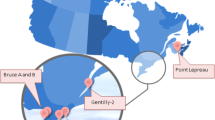A leading factor determining the prospects for nuclear power is an assessment of the radiation safety of the environment and people. The anthropocentric (public health) and ecocentric principles of radiation protection are singled out and the role of the natural radiation background is described. Key environmental problems in the development of nuclear power are handling radioactive wastes and spent nuclear fuel, radiation accidents with emission of radionuclides into the ambient environment and decommissioning of NFC enterprises. The importance of harmonizing the standards for admissible irradiation of man and biota is noted.
Similar content being viewed by others
References
Conceptual Propositions of a Strategy for the Development of Nuclear Power in Russia in the 21st Century, NIKIET, Moscow (2012).
On a Strategy for Nuclear Power in Russian to 2050, National Research Center – Kurchatov Institute, Moscow (2012).
R. M. Alexakhin, Nuclear Power and the Biosphere, Energoatomizdat, Moscow (1982).
I. I. Kryshev and E. P. Ryazantsev, Ecological Safety and the Nuclear Power Complex in Russia, IzdAT, Moscow (2010).
V. M. Klechkovskii (ed.), On the Behavior of Radioactive Fission Products in Soils, Their Migration into Plants and Accumulation in Crops, Akad. Nauk SSSR, Moscow (1956).
R. M. Alexakhin, L. A. Buldakov, V. A. Gubanov, et al., Large Radiation Accidents: Consequences and Protective Measures, edited by L. A. Il’in and V. A. Gubanov, IzdAT, Moscow (2001).
Environmental Consequences of the Chernobyl Accident and Their Remediation: Twenty Years of Experience, Report of the Chernobyl Forum Expert Group “Environment,” IAEA, Vienna (2006).
Final Report of the International Mission on Remediation of Large Contaminated Areas Off-Site the Fukushima Dai-Ichi NPP, Oct. 7–15, 2011, IAEA, Vienna.
Recommendations of the International Commission on Radiological Protection, ICRP Publication 26, Annals ICRP, 1 (3), Pergamon Press, Oxford (1977).
Recommendations of the International Commission on Radiological Protection, ICRP Publication 60, Annals ICRP, 21 (1–3), Elsevier, Amsterdam (1990).
The 2007 Recommendations of the International Commission on Radiological Protection, ICRP Publication 103, Annals ICRP, 37 (2–4), Elsevier, Amsterdam (2007).
F. Brechignac, C. Bradshaw, S. Carroll, et al., Towards an Ecosystem Approach for Environmental Protection with Emphasis on Radiological Hazards, Intern. Union of Radioecology (2012).
T. G. Sazykina, A. I. Kryshev, and K. D. Sanina, “Nonparametric estimation of thresholds for radiation effects in vertebrate species under chronic low-LET exposures,” J. Environ. Biophys., 48, No. 4, 391–404 (2009).
A Framework for Assessment of the Impact of Ionizing Radiation on Non-Human Species, ICRP Publication 91, Annals ICRP, 33 (3), Elsevier, Amsterdam (2003).
Environmental Protection: the Concept and Use of Reference Animals and Plants, ICRP Publication 108, Annals ICRP, Elsevier, Amsterdam (2009).
Environmental Protection: Transfer Parameters for Reference Animals and Plants, ICRP Publication 114, Annals ICRP, Elsevier, Amsterdam (2009).
Radiation Protection and Safety of Radiation Sources: International Basic Safety Standards, No. GSR Part 3 (Interim), IAEA, Vienna (2011).
G. G. Polykarpov, “Conceptual model of responses of organisms, populations and ecosystems to all possible dose rates of ionizing radiation in the environment,” Rad. Prot. Dosim., 75, 181–185 (1998).
E. O. Adamov and I. Kh. Ganev, Ecologically Faultless Nuclear Power, NIKIET im. N. A. Dollezhalya, Moscow (2007).
E. V. Spirin, S. I. Spiridonov, R. M. Alexakhin, and S. S. Utkin, “Radioecological evaluation of a uranium deposit for validating the radiation-migration balance of long-lived wastes,” At. Énerg., 114, No. 1, 34–39 (2013).
G. Voigt and S. Fesenko (eds.), Remediation of Contaminated Environments, Elsevier, Amsterdam (2009).
Author information
Authors and Affiliations
Additional information
Translated from Atomnaya Énergiya, Vol. 114, No. 5, pp. 243–249, May, 2013.
Rights and permissions
About this article
Cite this article
Alexakhin, R.M. Topical Environmental Problems of Nuclear Power. At Energy 114, 301–307 (2013). https://doi.org/10.1007/s10512-013-9715-x
Received:
Published:
Issue Date:
DOI: https://doi.org/10.1007/s10512-013-9715-x




